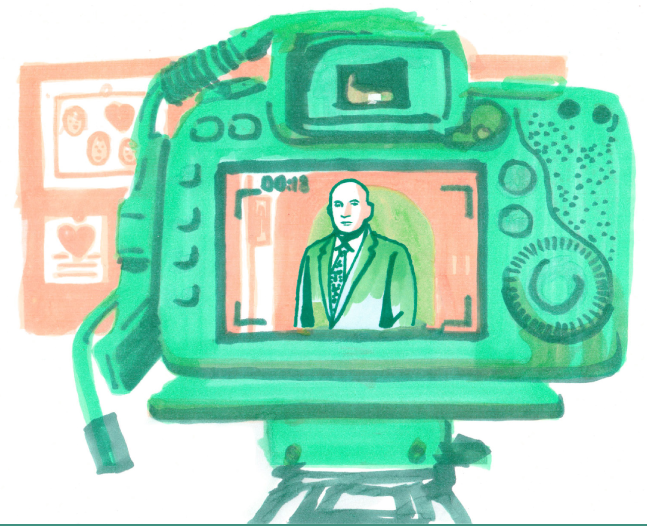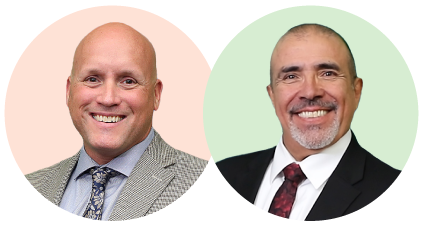Q&A: Connecting with Carter
How a superintendent partnered with his comms professional to build an authentic personal brand


Q&A: Connecting
With Carter
How a superintendent teamed up with his comms professional to establish his personal brand

Dr. Carter Davidson was new to the district when he first took the helm at Arizona’s Litchfield Elementary School District #79 (LESD79). Like any new superintendent, he needed to establish strong relationships and win his community’s trust. But because this community didn’t know him, he also had the chance to build a reputation from the ground up. What did he want to be known for? Put another way—what did he want his personal brand to be?
Davidson knew he wanted Litchfield to see what mattered to him: authenticity, transparency and a commitment to putting kids first. But establishing that reputation across a district of over 10,000 students would be easier said than done. Luckily, he had an expert to help him build his brand: LESD79’s Executive Director of Communications and Partnerships Sam Nuanez.
Over the course of that first year, the two worked together not only to introduce Davidson to the community, but to show them what he stood for. Today, they continue to reinforce that personal brand through a multichannel campaign they’ve dubbed “Connecting with Carter.” The effort has been successful—so much so that the National School Public Relations Association honored Davidson among its 2024-25 Superintendents to Watch. But how exactly did Davidson and Nuanez do it? We sat down with the duo to discuss their partnership, their strategy and the complexities of crafting an authentic personal brand.
Why was it so important for both of you to build Dr. Davidson’s brand in the Litchfield community?
Davidson: I had been an external candidate, so people didn’t know me. It was important to find ways for everyone to feel connected to me—even if they hadn’t met me in person yet. We needed to make certain that both the internal and external community could see things in me that were desirous of a leader, whether that was open, honest, transparent communication or the fact that I’m student-focused. That was the intent.
Nuanez: When Dr. Davidson came in, I had only been here for about a year myself, so I was still learning the district, learning our communities. But I did know for a fact that it was my job to make sure that our community got to know him.
Dr. Davidson, as you entered this role, what did you want to be known for?
Davidson: Number one is authenticity. I pride myself on the fact that what you see is what you get. This is just who I am. All of us grow and evolve, of course, but in my 20-plus years in education, I’ve stayed pretty much the same guy. I’ve worked really hard to remain consistent and have that kind of integrity. If you ask me a question, I’m going to answer you as best I can—and you’re not going to find out later that I told somebody else something different.
Another is transparency. Our families deserve to know what’s happening, good or bad, and I don’t have anything to hide. If I see something wrong that we need to fix, I’m going to talk about it. I think those two things have allowed me, with Sam and our team’s support, to develop trust across the entire community.
Sam, as you got to know him, what impressed you about Dr. Davidson?
Nuanez: Dr. Davidson made my job extremely easy due to the fact that he’s really a genuine person. He’s honest, he’s transparent, and he’s open to input—not only from his leadership team, but from his community in general. That’s what really resonated with me. When he gets up in front of the camera, what you see is the true Dr. Carter Davidson.
No matter how hard you try, a new superintendent can’t meet every single person in the community right away. So how did you give your community a sense of who Dr. Davidson is?
Nuanez: I come from a background in broadcast news and video production. So when I first approached Dr. Davidson, I told him, “We’re going to get you on camera.” With video, people can see you speak. They can see your body language, your facial expressions—and that, I think, really accelerates the connection. Dr. Davidson is also really personable, which gave me something to work with on camera.
And it was not just the video; we utilized multiple platforms. I made sure that we were consistently getting him out there—getting photos of him greeting parents and kids at pickup lines, or engaging with our community members at meetings. And that’s still the case. We have him on social media. We have him writing letters. We’re basically hitting all the platforms that we can, getting him in front of as many people as we can.
To make sure that we had something to wrap it all around, we came up with “Connecting with Carter.” Everything that we do revolves back to that. I think that has really helped him connect to our community. When we get out there, he’s recognized now. People know who he is and what he stands for.
Davidson: We’re in the people business. So a lot of the videos and pictures and stories that Sam has helped share are around building relationships or interacting with others—whether it’s employees or students or community members. We’re literally capturing people connecting with me, in real time.
How does Dr. Davidson’s personal brand complement the LESD79 district brand?
Davidson: Even before I was officially on board, Sam and I talked a lot about the Litchfield brand and how I could add value to that. We recently rolled out our new strategic plan, and one of the keystones in that strategic plan is “Relationships.” Among other things, that means we care about communicating with our stakeholders and partnering with them to support our “Litchfield Learners.”
So if there’s a story with me in it, we’re always making sure that we also get kids in there and that we’re focusing on the real reason we’re here. For example, we’ve introduced a kids edition of our “Connecting with Carter” videos where we actually go into the schools and talk to the students. We’ve gotten a lot of great feedback, not only from the community but from the students themselves. At the end of the day, everything we do—including branding—is about making their learning experience the best that it can be.
Nuanez: Now that we have this new strategic plan, everything that we do in our district revolves around the characteristics that we want to see in our Litchfield Learners—and the best way to teach those characteristics is by modeling. So we make sure that we’re adhering to those standards as a leadership team, and that filters down into the student community as well. When they see that Dr. Davidson is a strong communicator, that he’s a man of character, that he’s open to feedback—they’re going to want to be the same.
How are you establishing Dr. Davidson’s personal brand with employees?
Nuanez: You’ve got to be careful with a new superintendent. Sometimes you get so focused on that connection with the outside community that you leave your internal people lingering in the shadows. But we’ve made a very conscious and strategic effort to make sure that we are communicating just as strongly internally when it comes to Carter and his brand. We want to make sure our employees are just as connected to him as anybody else in the community—maybe even more so because they’re the ones in the trenches with us every day doing all the hard work.
Davidson: We just continue to look for ways for people to connect with me. Tomorrow the team and I will go out and have an employee chat with our transportation department—a group of people who may not feel a strong connection to the superintendent. We need to make certain that everybody knows me and knows what I stand for. So we’ve made an effort this year to really connect to those operational groups, not just parents, teachers and principals.
How have you stayed authentic while intentionally curating a personal brand?
Nuanez: Too many times in PR and marketing, people fail by trying to create the brand that they think people want. So we just decided to prioritize being genuine. When I met Carter, I truly believed that we didn’t have to massage anything. All we needed to do was turn on a light and hit the go button on the camera—because everything we needed was already right there. That’s still true, and it makes the job a lot easier.
Davidson: I would agree: You’ve got to remain genuine. Share your story. Answer questions in a manner that allows you to express your heart, your opinion, your professional thought—but don’t give people a line just because you think that’s what they want to hear. They’ll figure that out real quick.
Dr. Davidson, what advice would you give to supers who are working on building their personal brands?
Davidson: I hope superintendents understand the power of public relations. I don’t just need Sam when there’s a crisis—there’s so much more that PR can do. As new superintendents get to know their public relations professionals, they should think about their working relationship as a partnership. Work with your PR professional on what it means to establish a brand. Talk about whether your personal brand aligns with that of your district. If you just see PR as reactionary, you’re not going to get as much success. I know that I wouldn’t be as successful without the work of Sam and our team.
Sam, what advice would you give to other school communicators who are helping their superintendents build personal brands?
Nuanez: I’ve always believed that you have to create a really strong relationship with your superintendent—learn their voice, who they are and what they stand for. Now that I’ve been with Carter for a while, I know him well enough that I can generate copy for him that’s not very far off of what he’s thinking himself. To me, that has been instrumental in accelerating our communications. But you can’t learn your superintendent’s voice unless you really get a handle on who they are as a person. You’ve got to really know where they’re coming from, where their heart is and where their head is at.
Davidson: And Sam, if I can add something—I think that boils down to trust. That relationship will foster trust. And when you have that trust, you can get stuff done a lot faster.
Nuanez: Absolutely. And once you get to that point—the trust, knowing who they are—the rest falls into place.
